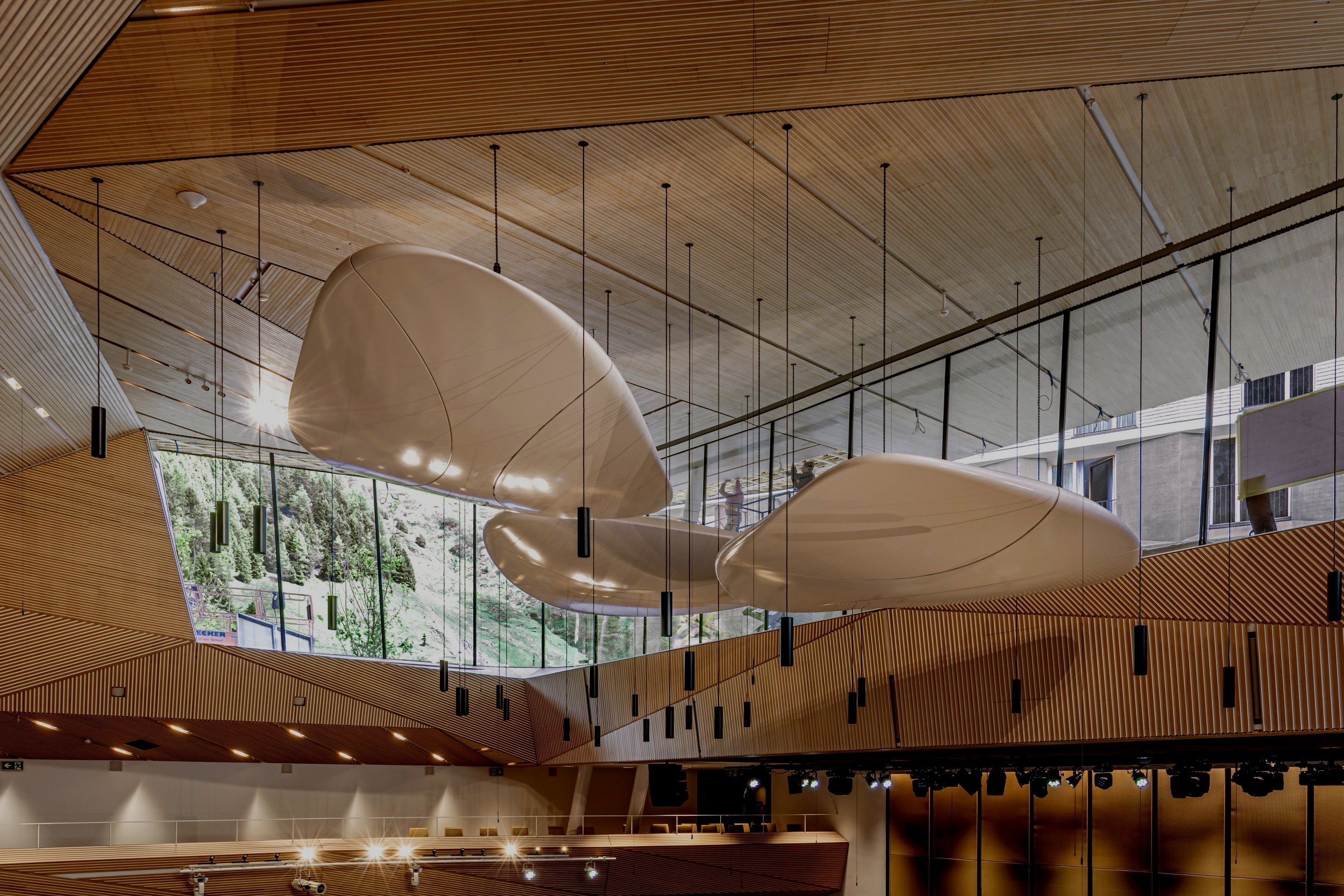
ANDERMATT CONCERT HALL
BRINGING DREAMS TO REALITY IN THE SWISS ALPS
Once better known as a high-end ski destination, Andermatt has been distinguishing itself as a world-class music destination since the 2019 opening of its state-of-the-art Andermatt Concert Hall. The first of its kind in an Alpine village, Studio Seilern Architects’ landmark design has received the 2022 Architizer A+ jury prize for Cultural Hall/Theater and widespread acclaim for its innovative acoustics.
Remarkably, what’s now a 650-seat concert hall was not initially intended for musical events at all. Instead, the project began with the shell of a preexisting building destined to become a single-purpose conference center.
“The windowless, underground 2,000 cubic meter concrete box,” described in Wallpaper Magazine, was at the time “better suited for a nuclear bunker than a performance of Beethoven’s Fifth.” However, lifelong classical music lover and investor Samih Sawiris saw his chance to use the preexisting structure to realize a longstanding dream.
Sawiris, who sat in the back of hundreds of Berliner Philharmoniker concerts during his student days in Berlin, turned to Studio Seilern to pursue a dream many thought impossible: to create a world-class concert facility in Andermatt equal to famous halls across European capitals.
Sawiris performing for Lena-Lisa Wüstendörfer, current director of Andermatt Concert Hall. Credit Geri Born.
To achieve this vision, Studio Seilern proposed lifting a large section of the preexisting roof of the convention center, doubling the acoustic volume to 5,340 m3 while letting in daylight and picturesque alpine views.
Simultaneously, the interior’s “origami configuration” was conceived through a partnership with Kahle Acoustics. Perforated triangular oak panels, together with sloping parapets, and the sculpted wooden ceiling, introduce balance and create an impressive early hall response.
Three hanging reflectors help to even out the hall’s acoustic. Credit Amadeus Active Acoustics.
However, planning parameters meant that only a portion of the roof could be elevated. This limited the total volume of the hall and left the stage in an especially low configuration.
The low configuration created a room better suited for solo artists or string quartets but lacked the enveloping reverberation necessary for orchestral performances. Further, the hall’s design exhibited a significant change in acoustics from rehearsals in an empty hall and a fully-occupied concert.
Kahle approached Amadeus Active Acoustics to ensure the space, which was still too small to support a symphony, would deliver on the multiple uses the hall required. The Amadeus team worked to create more reverb, especially to allow early reflections to travel through differing ceiling heights to create a balanced sound for each seating area.
It was critical to preserve the integrity of Studio Seilern’s design when installing loudspeakers on the walls and ceiling. Credit Amadeus Active Acoustics.
The Amadeus design team worked closely with Kahle to understand their acoustic design and develop a system around it. Sixty-eight loudspeakers and eight subwoofers from Renkus-Heinz and Atlas Sound sound columns were selected to comprise the main audio equipment, alongside 32 supercardioid DPA sc490 microphones. The Amadeus Core was installed to lengthen and enhance reverberation to create a late hall response for every desirable type of event.
Presets were created, and the speakers were calibrated. Then, the Amadeus team returned to attend concerts with Kahle Acoustics to define Andermatt Hall’s acoustic with the active input of musicians and conductors.
During the artistic tuning phase, Amadeus Active Acoustics worked with the Berlin Philharmonic Orchestra, the European Chamber Orchestra, Daniel Barenboim, Maxim Vengerov, Jonathan Brett, and others. These early guests of the concert hall were immensely happy for the support and possibilities that Amadeus brought to their performances. Together decisions were made on how to define the young concert hall’s acoustics, each time improving on what had learned along the process.
Amadeus Active Acoustics worked with ensembles and orchestras to address the needs of conductors and musicians on the spot. Credit Amadeus Active Acoustics.
There was a rich spirit of experimentation and a feeling that everyone involved in the artistic tuning phase was partaking in a changing standard for classical performances.
In particular, pianist Giuseppe Guarrera brilliantly exploited the Amadeus Core’s possibilities to integrate new levels of variation into his performance. In rehearsals for his solo recital during the Andermatt Music Festival, Guarrera requested different levels of reverb, finally opting for different settings for each stylistic period of repertoire.
“In the end, it’s about how the musicians work with sound. We could experience that together and realize the artist’s dream acoustic”
— Fabio Kaiser
Christian Simmen, Director of Engineering, Andermatt Concert Hall praised the Amadeus Core’s “versatile use” for “year-round utilization.” Conductor Jonathan Brett remained impressed by the amount of dynamic range achieved and the “high degree of intimacy” present while sounding “like a bigger hall.”
Reaching the most balanced natural acoustic possible for an atypical space while providing a high level of flexibility for performing artists makes the Andermatt project illustrative of the enhanced potential of incorporating the Amadeus Core as a permanent fixture in a newly-built hall. Meanwhile, witnessing artists exploit the system to express themselves while expanding their approach to sound is the truest possible expression of Amadeus’s mission to increase the standard of 21st-century acoustics.




